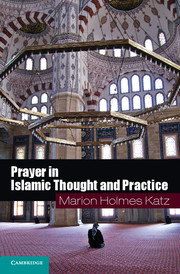4 - The community at prayer
Congregational prayer, prayer leadership (imāma), and the boundaries of the religious community
Published online by Cambridge University Press: 05 April 2013
Summary
Muslim scholars of all schools agree on the religious value of congregational prayer. The Prophet is reported to have stated, “Prayer in congregation is superior to prayer by an individual by twenty-seven degrees” (or, in some versions, twenty-five), which was understood to mean that its merit and reward were multiplied this number of times. In another well-authenticated report the Prophet declares:
If you were to pray in your homes as this person who stays behind (al-mutakhallif) prays in his home, you would abandon the way of your Prophet, and if you abandon the way of your Prophet, you will go astray. Any man who purifies himself thoroughly and then sets out for one of these mosques, God will record a good deed for every step that he takes and raise him a degree because of it, and will take away one of his sins.
The unique value of public prayer could even function as a rationale for favoring urban life; one ḥadīth text represents the Prophet as worrying that love of the milk of their flocks may lead recently sedentarized Muslims to “return to the desert, leaving the places where men pray together.”
Ḥanafīs and Mālikīs consider congregational ṣalāt to be a confirmed sunna (sunna muʾakkada) for all obligatory prayers, rather than a strict obligation; similarly, Imāmī Shīʿites regard it as desirable (mustaḥabba). Ḥanbalīs are distinctive in regarding it as mandatory for individuals (or at least individual men). There was a difference of opinion within the school about whether failure to fulfill this obligation without a valid excuse (ʿudhr) voided one’s prayers; most Ḥanbalīs held that a person who willfully prayed alone was sinful but that the prayer still counted. Shāfiʿīs consider congregational prayer to be obligatory upon the community as a whole (farḍ kifāya), rather than upon individuals; enough adult males must participate in order for it to function as a visible emblem (shiʿār) of Islam.
- Type
- Chapter
- Information
- Prayer in Islamic Thought and Practice , pp. 128 - 176Publisher: Cambridge University PressPrint publication year: 2013



